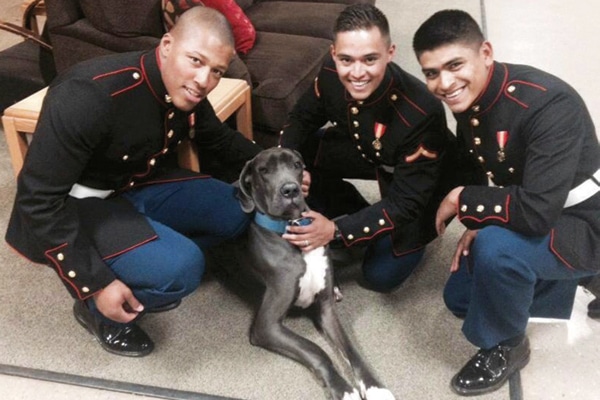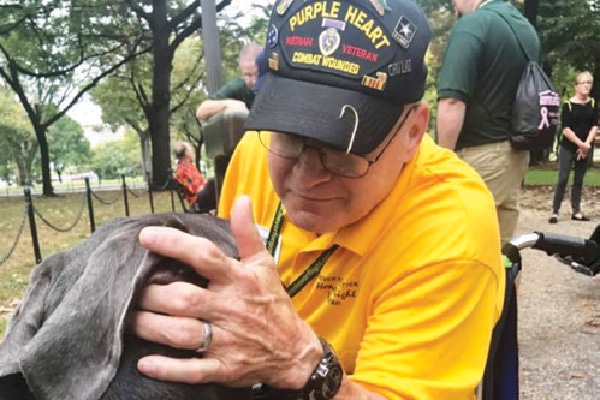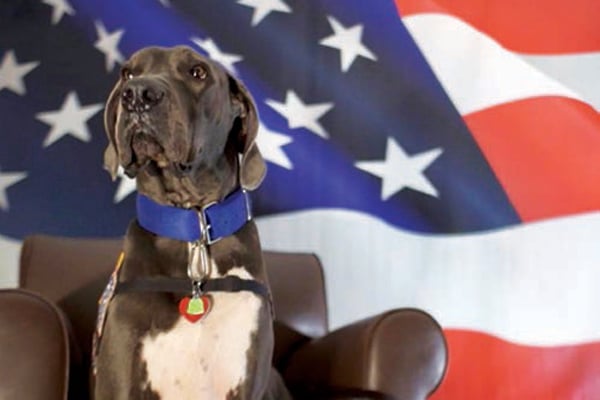Bandit, a European Blue Great Dane puppy, was scheduled to be euthanized. He had a softball-size lump growing from his neck, and the group that had taken in him and his siblings didn’t have the funds required to help him.
Luckily, Kelly Brownfield, a USO Western Missouri regional operations director, was at the same vet getting her newly adopted pup checked out. Without hesitation she scooped up Bandit. “I made the decision there,” she explains, “that he was coming home with me.”
It turned out that Bandit’s issues were because of a piece of wood stuck in his back tooth — a relatively easy and inexpensive fix. Kelly had always wanted a Great Dane. Now she had two!
Bandit finds his calling

Kelly has a job where she can bring her dogs to work — the USO of Missouri, Inc. Bandit loved the service men and women and wanted to be with them.
“When soldiers were having issues, we would find him [Bandit] in the lap of a crying solder,” Kelly says. “He knew how to sense out people.” A number of people pitched in training so that he could pass the tests required to become a registered therapy dog. These are tests he has to retake and pass annually.
Today, Kelly owns Bandit and Maverick, another European Blue Great Dane, who are both registered through the Alliance of Therapy Dogs, part of a nationwide therapy dog group whose certification is good state to state. Their work isn’t isolated to the USO of Missouri, Inc. Kelly, Bandit and Maverick conduct tours of the East Coast. This allows other service members to interact with the dogs. Travel is by car — it’s a little difficult to get two giant pups on a flight with you!
Bandit’s big heart

Bandit’s list of accomplishments is long. What he enjoys most is working with the men and women in uniform. “I know he loves doing this,” Kelly says. “His vest is filled with patches and pins of units he has worked with. In the morning when I say it is time to go, he is so excited to see his vest come out.”
Bandit will be brought into a room of service men and woman and given the chance to cuddle up to each one. Interactions are watched closely. If one of the humans shows excessive emotion while with Bandit there is a good chance there is an underlying concern, issue or signs of PTSD. Bandit allows the service men and women, who have been through so much, to feel safe enough to break down their emotional barriers and connect with their deepest feelings. This alerts others that the soldier may need additional treatment and help.
In his prime, Bandit spent time at the hospital as stability support, helping wounded warrior amputees get back on their feet. Bandit himself has physical deformities that makes it harder for him to walk. He has had five surgeries leaving him with screws in his back legs. Soldiers who have lost limbs connect easily with Bandit. After being suited up in a special harness, Bandit would walk next to a patient trying out his/her artificial leg. Bandit’s size is a plus, making him, with his harness in place, the perfect height to add some balance to a soldier’s first few steps. Bandit does everything he can to prevent his partner from falling, even if a new leg fails.
Beyond the USO

Bandit’s special touch doesn’t stop at the military members; it extends to their families. Many children who visit the USO find Bandit to be not just a dog but a friend; a soft and loving creature they can play with, hug and tell their secrets to. Bandit has been the partner for children at their fallen parent’s funeral. He walks with the child to the graveside, staying with him or her and being the supportive best friend that the child desperately needs at that time.
At 7 years old, Bandit is a senior dog. He is still active in his work with the USO, but a few activities that are more physical or require extensive patience have been handed down to Maverick. Bandit seems OK with letting his brother take on some of the job as long as he gets to be with his friends in uniform.
When he gets home, Bandit has plenty of time to hang out with his cat, Lola, before cuddling up in the human bed with Maverick, Lola and his mom. A cozy foursome!
Due to Bandit’s success, Kelly has shared their process and guidelines with other USO offices in the hopes that the program can go nationwide. When asked why Bandit likes his job Kelly says, “I think he just loves people, and he loves what he does. It’s almost like he was born for this. Sometimes I wonder if we saved him within minutes of him being put down; if this is his way of giving back.

A Q&A with Kelly Brownfield
Working dogs are just like us
Q: What is Bandit’s diet?
A: Bandit has thrived eating Purina Pro Plan. His favorite flavor of Purina Pro Plan is the Chicken & Rice Formula.
Q: Does Bandit get any human food?
A: He loves chicken, which has become a weekly Sunday routine — to treat him to his cooked chicken.
Q: What type of gear does Bandit use?
A: Bandit is known for his vest, which is worn at most of his encounters when working with the public and our military. We also take precautions to protect his ears and eyes. He uses military-grade goggles and mutt muffs if the situations call for them. When Bandit was helping provide stability support to our military amputees, he used a special harness.
Q: Are there health issues that Bandit’s job cause him to have, and how do you address those?
A: Bandit was born with some deformities. He walks on the edge of his right front paw and due to the front leg deformity, it has caused a slope where his hind legs are higher. Due to that both ACLs ruptured, and he has had five surgeries over his lifetime leaving him with four plates and 20 screws in each of his back legs. We are lucky to have one of the most incredible veterinary schools in the country here in Missouri, the University of Missouri College of Veterinary Medicine, which has taken amazing care of our Bandit over the last seven years.
Q: What is Bandit’s grooming routine?
A: Bandit gets weekly baths, due to the large amount of therapy dog work he does to ensure he is clean. He loves when you pull out the grooming glove to brush his hair. I try to treat him to a full spa day once a month at the local groomer, Pampered Paws, LLC.
About the author
Wendy Newell is a former VP of Sales turned dog sitter, which keeps her busy being a dog chauffeur, picking up poop and sacrificing her bed. Wendy and her dog, Riggins, take their always-changing pack of pups on adventures throughout the Los Angeles area. Learn more about them on Facebook @The Active Pack and on Instagram @wnewell.
Editor’s note: This article appeared in Dogster magazine. Have you seen the new Dogster print magazine in stores? Or in the waiting room of your vet’s office? Subscribe now to get Dogster magazine delivered straight to you!





